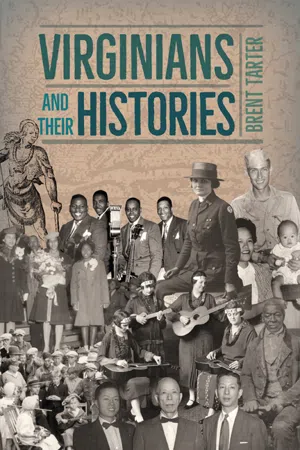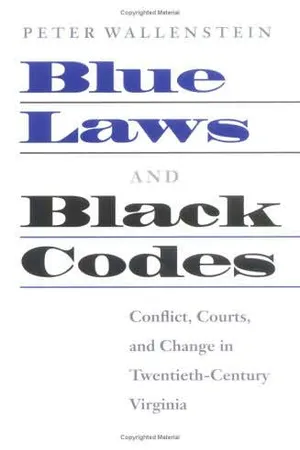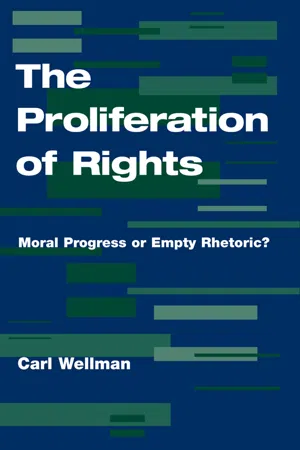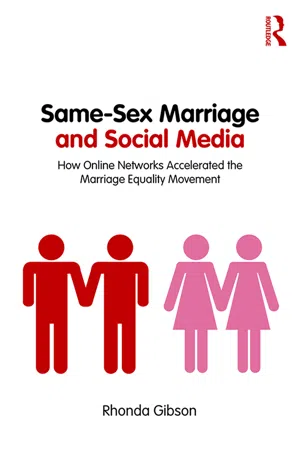History
Loving v Virginia
"Loving v. Virginia" was a landmark civil rights case in which the U.S. Supreme Court declared laws prohibiting interracial marriage unconstitutional. The case involved Richard and Mildred Loving, a white man and a black woman who were convicted under Virginia's anti-miscegenation laws. The Court's ruling in 1967 invalidated such laws nationwide, affirming the right to marry regardless of race.
Written by Perlego with AI-assistance
Related key terms
Related key terms
1 of 4
Related key terms
1 of 3
5 Key excerpts on "Loving v Virginia"
- eBook - ePub
Race, Sex, and the Freedom to Marry
Loving v. Virginia
- Peter Wallenstein(Author)
- 2014(Publication Date)
- University Press of Kansas(Publisher)
CHAPTER 6Loving v. Virginia and the US Supreme Court
Richard Loving, a private and taciturn man, put more words together for public consumption than usual after the Virginia Supreme Court ruled against him and Mildred in March 1966. Now they would have to take their appeal to the nation’s highest court. “We have thought about other people,” he told a reporter in Richmond, “but we are not doing it just because someone had to do it and we wanted to be the ones. … We are doing it for us — because we want to live here,” in Virginia. He was not discounting the broader significance of their action and its possible success, but that was not what animated him or his bride, although Mildred Loving told Hope Ryden that her family could always go back to DC but she saw the importance to others of their pursuing “the principle” of it all. This was no contrived case. It came, as great constitutional cases generally do, out of real world concerns, in which someone’s life, liberty, or property turned on the outcome.First the Lovings had to convince the nation’s highest court even to hear their case. In their jurisdictional statement to the Court, attorneys Bernard Cohen and Philip Hirschkop began with facts that would have been unavailable even three years earlier. The Civil Rights Act of 1964 and the Voting Rights Act of 1965 were both on the books, they noted, so “the elaborate legal structure of segregation has been virtually obliterated with the exception of the miscegenation laws.” As for those remainders from the panoply of Jim Crow statutes, they went on, “There are no laws more symbolic of the Negro’s relegation to second-class citizenship. Whether or not this Court has been wise to avoid this issue in the past, the time has come to strike down these laws; they are legalized racial prejudice, unsupported by reason or morals, and should not exist in a good society.”As the Court considered whether to hear the case, Justice John Marshall Harlan’s clerk said it another way. “The miscegenation issue … was left open in McLaughlin - eBook - ePub
- Brent Tarter(Author)
- 2020(Publication Date)
- University of Virginia Press(Publisher)
In 1967 the Supreme Court declared that state laws that prohibited interracial marriage were unconstitutional. As with many other landmark cases, this one also arose in Virginia. Mildred Jeter, of mixed European, African, and Rappahannock ancestry (and therefore “colored” according to the 1924 Act to Preserve Racial Integrity) had married a white man, Richard Loving. They were married in Washington, D.C., because the Racial Integrity Act prohibited marriage between white and “colored” people in Virginia. The law also prohibited mixed-race couples from living together in Virginia as wife and husband even if they had married in a place where mixed-race marriages were legal. They were arrested in their Caroline County home and convicted of violating the law. The presiding judge suspended their jail sentence on condition that they never live together in Virginia. In effect, he banished them from the state.After barriers to registration and voting were eliminated, African Americans eagerly took the opportunity to register and vote, as in this scene in Portsmouth.The Lovings resided for a time in Washington, D.C., but eventually they quietly returned to Virginia. Arrested a second time and with legal assistance they appealed the conviction. The Virginia Supreme Court of Appeals refused to overturn the circuit judge’s order, and they appealed to the Supreme Court of the United States. In Loving v. Virginia the court ruled in 1967 that in spite of a very long tradition of allowing states to regulate conditions of marriage, the right to marry was a fundamental human right that the Constitution of the United States protected. The decision made laws against interracial marriage invalid throughout the country.Mildred and Richard LovingThose important court decisions as well as actions of Congress provoked much controversy in Virginia, as elsewhere. Such white supremacist organizations as the Defenders of State Sovereignty and Individual Liberty—the Virginia counterpart of the more violent White Citizens Councils in other states—mobilized public opinion to delay or obstruct implementation of federal laws and court orders. Many of the most influential political leaders in the state condemned actions of Congress and the federal courts. Senator Harry Flood Byrd and almost all the southern members of both houses of Congress signed the Southern Manifesto against desegregation. Like opponents of desegregation elsewhere, they blamed outsiders (members of Congress, federal judges, and national civil rights organizations such as the NAACP) for the federal government’s intrusion into what they regarded as matters within the sole control of the states. In truth, though, the court cases that arose in Virginia were the work of Virginians who challenged Jim Crow laws; and the strong opposition to the civil rights movement in the South, including much revolting violence, ultimately generated political support for stronger congressional action. - eBook - ePub
Blue Laws and Black Codes
Conflict, Courts, and Change in Twentieth-Century Virginia
- Peter Wallenstein(Author)
- 2013(Publication Date)
- University of Virginia Press(Publisher)
Other Virginians had spent years in prison for breaking that law, and now it looked like two more people would join their ranks. The Lovings were terrified at the prospect. They were free while awaiting their trial, but a trial nonetheless loomed. Not only was there no way to turn the clock back to May, they would not have wanted to. They wanted to be married, and they wanted to live together in peace in their rural community. Richard Loving had thought they could do both if they went out of state to marry, but they discovered that the same law banning their getting married in Virginia also outlawed their living together there as an interracial married couple, expressly so if they had briefly left the state to evade the law that prevented their marrying each other in Virginia.Virginia was by no means alone in maintaining a law—termed a “miscegenation” law—against marriages between people identified as white and other people, especially African Americans but sometimes also Asian Americans and Native Americans. From 1913 to 1948 thirty states had miscegenation laws on the books (map 1), and as late as 1958, when the Lovings were arrested, twenty-four of the forty-eight states retained such laws. The last of those states outside the South dropped theirs in 1965.2 Retaining such laws were all seventeen states of the Deep South, the Upper South, and the Border South (map 2): all eleven states of the former Confederacy plus Delaware, Maryland, Kentucky, Missouri, Oklahoma, and West Virginia.The prospect of successfully challenging the Virginia law’s constitutionality was not bright, though court challenges had occasionally succeeded in other states. In the history of the Republic, four state supreme courts ruled against the constitutionality of a miscegenation law. During Reconstruction, in the 1870s, three states did so—Alabama, Louisiana, and Texas—before reversing themselves, restoring such statutes, and leaving them in place, where they remained until 1967. In 1948, by a 4–3 vote, the California Supreme Court did so, but no other state supreme court followed, in or out of the South.3 - eBook - ePub
The Proliferation Of Rights
Moral Progress Or Empty Rhetoric?
- Carl Wellman(Author)
- 2018(Publication Date)
- Routledge(Publisher)
It argued that because marriage has traditionally been subject to state regulation without federal intervention, the regulation of marriage should be left to exclusive state control. The Supreme Court granted that marriage is a social relation subject to the state’s police power but denied that its power to regulate is unlimited. In particular, this power is circumscribed by the Fourteenth Amendment. Just as the state’s police power is not unlimited, so no individual right is absolute. Although any statute infringing a civil right must be subjected to the most rigid scrutiny and thus bear a very heavy burden of justification, it will be upheld if the court finds it necessary to some legitimate overriding state purpose. As one would expect, Virginia argued that its laws prohibiting interracial marriage were necessary to promote public morals and to preserve the racial integrity of its citizens. In Reynolds v. United States and later in Mormon Church v. United States, the Supreme Court had upheld state statutes prohibiting polygamy on the ground that polygamy is contrary both to the moral principles upon which our government rests and to the spirit of Christianity. Virginia argued that because interracial marriage is immoral and an interference with the will of God, the Court should uphold the laws prohibiting the marriage of white and colored persons on the same grounds. Again, the Supreme Court in Buck v. Bell had upheld on eugenic grounds a law authorizing the sterilization of feebleminded persons confined to state institutions, clearly an abridgment of the civil right to procreate. Because interracial marriages are biologically harmful, in that they tend to produce inferior offspring, Virginia’s law prohibiting blood-mixing should be held to be constitutional - eBook - ePub
Same-Sex Marriage and Social Media
How Online Networks Accelerated the Marriage Equality Movement
- Rhonda Gibson(Author)
- 2018(Publication Date)
- Routledge(Publisher)
With the abolition of slavery in the mid-1800s, freed slaves were granted marriage rights, but only with other members of minority groups – they were still prohibited from marrying Whites (Coontz, 2005). In 1883, in Pace v. Alabama, the U.S. Supreme Court gave its stamp of approval to these laws, unanimously ruling that state-level bans on interracial marriage did not violate the Equal Protection and Due Process clauses of the U.S. Constitution’s Fourteenth Amendment. It was not until 1967 that the U.S. Supreme Court unanimously overturned Pace, ruling in Loving v. Virginia that state bans on interracial marriage were indeed in violation of the Fourteenth Amendment. Interestingly, the Supreme Court’s decision in Loving was made despite prevailing public opinion (73 percent) that overwhelmingly opposed such marriages, a judicial/public opinion split that has also emerged in the battle for marriage equality. Attitudes about the purpose of marriage have also shifted over time, and the idea of marrying for love is a relatively recent concept (Coontz, 2005). It was not until the 1800s that couples began to value marriage for its ability to provide companionship and intimacy, although still within a framework of rigid gender roles and with some degree of parental control. Psychologist and sexual prejudice expert Gregory Herek points to this shift, which accompanied a transition from an agrarian society to an industrialized one, as evidence that marriage is an adaptable institution: “As cultural definitions of marriage have evolved in the United States and other Western countries, relationship quality and its constituent components have become increasingly central to the meaning of that institution” (Herek, 2006, p. 609). Under this new conceptualization, marriage was valued not only for the reproduction of children, but also for personal fulfillment and accompanying privileges
Index pages curate the most relevant extracts from our library of academic textbooks. They’ve been created using an in-house natural language model (NLM), each adding context and meaning to key research topics.
Explore more topic indexes
Explore more topic indexes
1 of 6
Explore more topic indexes
1 of 4




